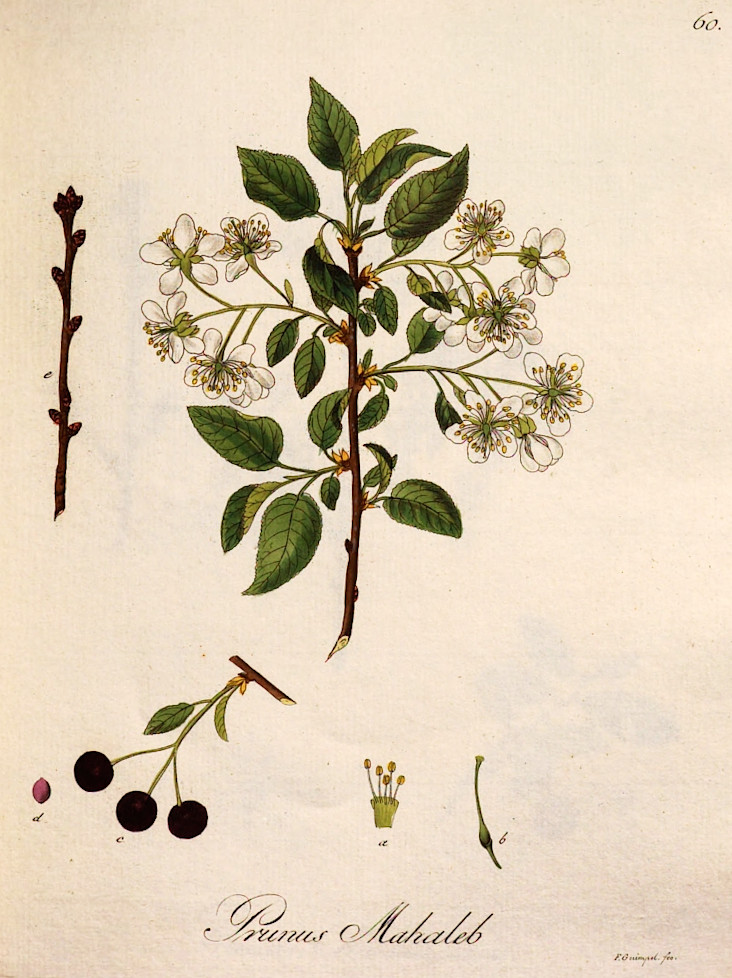Prunus mahaleb L. - Rosaceae - mahaleb cherry, St.Lucie cherry, perfumed cherry, Steinweichsel, Felsenkirsche
Deciduous shrub or tree, native to central and southern Europe, naturalised and introduced elsewhere as a rootstock for commercial cherries; stem and twigs not thorny, bark grey-brown, twigs with terminal end buds; leaves petioled (4-20mm), broadly ovate, oblong, or suborbiculate, base usually rounded to truncate, sometimes subcordate, margins crenate; inflorescences corymbs 4-10-flowered, flowers fragrant, blooming at leaf emergence, petals white, elliptic to obovate, 6-7mm; fruit small, thin-fleshed, cherry-like drupe 6-10mm in diameter, green turning red to dark purple and black when mature, very bitter; stones ellipsoid to subglobose.
Steinweichsel (wikipedia) Prunus mahaleb in Flora of North America
„Its fruits are small, slightly bitter and edible, from which a purple dye is obtained. The seeds are
used more. An aromatic spice is produced, having a taste similar to almond seeds. This spice was used for centuries in the Middle East and North Africa to flavour bread, cakes, cheese, cookies, etc.“
[Popescu, I., and G. Caudullo. „Prunus mahaleb in Europe: distribution, habitat, usage and threats.“ 2020] PDF
Volatile components of the fruit kernel included dihydrocoumain, coumarin, and herniarin (7-methoxycoumarin).
[Al-Said, Mansour S., and Mohamed S. Hifnawy. „Dihydrocoumarin and certain other coumarins from Prunus mahaleb seeds.“ Journal of Natural Products 49.4 (1986): 721-721]
„Volatile constituents from air-dried flowers, leaves, stem-bark and wood of Prunus mahaleb L. (Rosaceae) were isolated by steam-distillation and analysed using GC and GC-MS.“ Main components of the bark volatiles were coumarin (34.1%), hexadecanoic acid (9.3%) and linoleic acid (5.3%); minor components include nonanal (1.1%), (E)-2-nonenal (1.3%), (E,Z)-2,6-nonadienal (0.2%), decanal (0.7%), 2-dodecenal (0.2%), (E,E)-2,4-decadienal (0.5%), linalool (0.6%), borneol (0.8%), α-terpineol (0.5%), thymol (0.3%), (E)-nerolidol (0.4%), benzaldehyde (0.3%), and dihydrocoumarin (0.6%). Main components of the wood volatiles were eicosane (46.0%) and hexadecanoic acid (12.9%), minor ones included coumarin (4.5%).
Main components of the dried flower volatiles were heneicosane (22.1%) and octacosane (13.0%); minor components included e.g. nonanal (1.9%), 2-dodecenal (0.1%), tridecanal (0.3%), tetradecanal (0.4%), limonene 0.3%), linalool (4.1%), α-terpineol (1.4%), 2-caren-4-one (4.8%), nerol (0.5%), geraniol (1.3%), (E)-β-damascenone (0.9%), (E)-β-ionone (1.3%), (E)-nerolidol (0.2%), benzaldehyde (0.2%), anisaldehyde (0.7%), 1,4-dimethoxybenzene (2.2%), 2-phenylethanol (0.5%), p-tolualdehyde (1.0%), coumarin (2.3%), hexyl benzoate (0.8%), methyl 2-methoxybenzoate (0.2%), and (Z)-jasmone (0.2%).
[Mastelić, Josip, Igor Jerković, and Milan Mesić. „Volatile constituents from flowers, leaves, bark and wood of Prunus mahaleb L.“ Flavour and fragrance journal 21.2 (2006): 306-313]
Prunus mahaleb L. honey: „High vomifoliol percentages (10.7-24.2%) in both extracts (dominant in solvent B) and coumarin (0.3-2.4%) from the extracts (more abundant in solvent A) and headspace (0.9-1.8%) were considered characteristic for P. mahaleb honey and highlighted as potential nonspecific biomarkers of the honey’s botanical origin.“
Other volatiles isolated by HS-SPME (PDMS/DVB) were e.g. anisaldehyde (1.4-10.9%), benzaldehyde (2.0-4.5%), phenylacetaldehyde (0.5-2.8%), linalool (4.0-6.6%), lilac aldehydes (1.0-11.7%), lilac alcohols (0.1-1.2%), cis- and trans-linalool oxide (0.6-3.1%), 4-ketoisophorone (5.0-7.4%), α-isophorone (2.1-6.5%), 2-hydroxyisophorone (0-0.9%), 2-hydroxy-4-ketoisophorone (0-0.6%) and safranal (0-1.0%).
[Jerković, Igor, Zvonimir Marijanović, and Mladenka Malenica Staver. „Screening of natural organic volatiles from Prunus mahaleb L. honey: coumarin and vomifoliol as nonspecific biomarkers.“ Molecules 16.3 (2011): 2507-2518]
Coumarin content in Prunus mahaleb kernels was 0.87mg/g and in ‘Mirinello di Torremaggiore’ liqueur it was 740mg/L.
[Ieri, Francesca, Patrizia Pinelli, and Annalisa Romani. „Simultaneous determination of anthocyanins, coumarins and phenolic acids in fruits, kernels and liqueur of Prunus mahaleb L.“ Food chemistry 135.4 (2012): 2157-2162] PDF
„Mahaleb, which is a spice with culinary use in Eastern and Mediterranean countries, is a natural source of coumarin. Its presence in bakery ware has not yet been studied, despite the fact that it is widely used in traditional products… Coumarin contained in the tested bakeryware ranged from 1.6 to 109 mg/kg. As a result, the permitted limit of 15 mg/kg set by Regulation (EC) 1334/2008 was in some cases exceeded by 7.3-times.“
[Krystalli, Evangelia, et al. „Effect of Temperature and Yeast on the Formation of Coumarin in Bakery Ware Containing Mahaleb. A Fully Validated Approach.“ Analytical Letters 54.16 (2021): 2551-2564]

Guimpel, F., Willdenow, C.L., Hayne, F.G., Abbildung der Deutsche Holzarten (1815-1820) Abbild. Deut. Holzart.
vol. 1 (1815) t. 60
http://plantillustrations.org/species.php?id_species=1265883

Prunus mahaleb flowering, CC BY-SA 3.0 Author: Andreas Kraska
